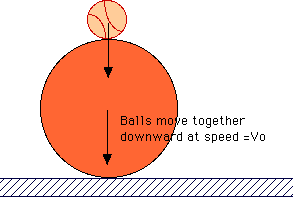| When two balls are dropped to the floor with the balls touching each other (as seen in the accompanying drawing below) some fascinating things happen when the balls hit the floor. Many students have seen this demonstrated in classes--use a basketball for the bottom ball and a baseball or softball for the top ball for an interesting result if you would like to try it on your own (be careful as rebound speeds can be high).
 Here’s the problem–it’s clear that the rebound speed of the top ball will depend upon the masses of the two balls, but how? Here’s the problem–it’s clear that the rebound speed of the top ball will depend upon the masses of the two balls, but how?
In other words,
Given the respective masses of the two balls (M1 and m2) and the impact velocity (v0), determine the height to which the top ball rebounds and the fraction of the kinetic energy of the system that is transferred to the top ball, both as a function of M1, m2, and v0.
Try the solution yourself before viewing our data. Good luck! |

